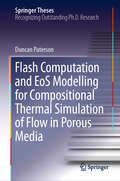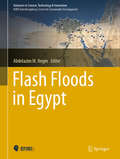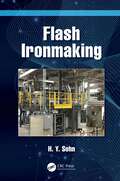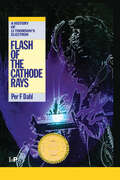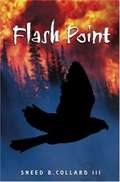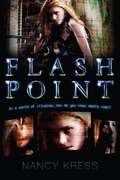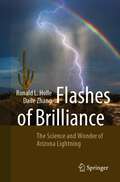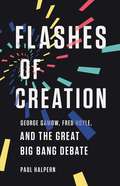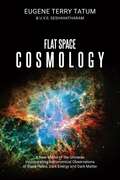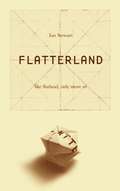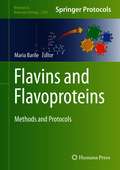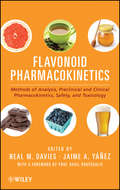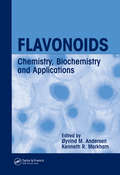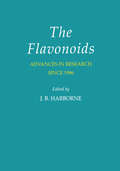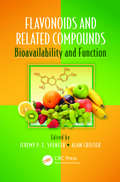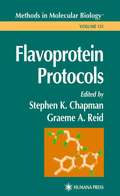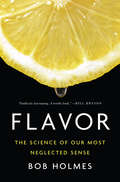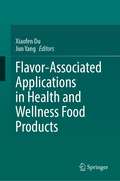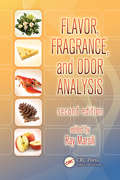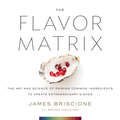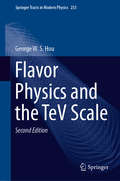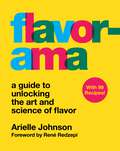- Table View
- List View
Flash Computation and EoS Modelling for Compositional Thermal Simulation of Flow in Porous Media (Springer Theses)
by Duncan PatersonThis book investigates a wide range of phase equilibrium modelling and calculation problems for compositional thermal simulation. Further, it provides an effective solution for multiphase isenthalpic flash under the classical framework, and it also presents a new flash calculation framework for multiphase systems, which can handle phase equilibrium and chemical reaction equilibrium simultaneously. The framework is particularly suitable for systems with many phases and reactions. In this book, the author shows how the new framework can be generalised for different flash specifications and different independent variables. Since the flash calculation is at the heart of various types of compositional simulation, the findings presented here will promote the combination of phase equilibrium and chemical equilibrium calculations in future simulators, aiming at improving their robustness and efficiency.
Flash, Crash, Rumble, and Roll (Let's-Read-and-Find-Out Science 2)
by Dr. Franklyn M. BranleyRead and find out about what causes the flash, crash, rumble, and roll of thunderstorms in this colorfully illustrated nonfiction picture book.Did you know that lightning bolts can be over a mile long? Or that they may come from clouds that are ten miles high? Storms can be scary, but not if you know what causes them. Before the next thunderstorm, grab this book by the expert science team Franklyn Branley and True Kelley and learn all about thunderstorms.This is a clear and appealing science book for early elementary age kids, both at home and in the classroom. It's a Level 2 Let's-Read-and-Find-Out, which means the book explores more challenging concepts for children in the primary grades. The 100+ titles in this leading nonfiction series are:hands-on and visualacclaimed and trustedgreat for classroomsTop 10 reasons to love LRFOs:Entertain and educate at the same timeHave appealing, child-centered topicsDevelopmentally appropriate for emerging readersFocused; answering questions instead of using survey approachEmploy engaging picture book quality illustrationsUse simple charts and graphics to improve visual literacy skillsFeature hands-on activities to engage young scientistsMeet national science education standardsWritten/illustrated by award-winning authors/illustrators & vetted by an expert in the fieldOver 130 titles in print, meeting a wide range of kids' scientific interestsBooks in this series support the Common Core Learning Standards, Next Generation Science Standards, and the Science, Technology, Engineering, and Math (STEM) standards. Let's-Read-and-Find-Out is the winner of the American Association for the Advancement of Science/Subaru Science Books & Films Prize for Outstanding Science Series.
Flash Floods in Egypt (Advances in Science, Technology & Innovation)
by Abdelazim M. NegmThis book presents the latest findings and information on flash floods in Egypt and presents case studies from various regions throughout the country. The quantitative and qualitative dimensions of these flash floods are discussed on the basis of statistical analysis and field observations. The book covers a broad and diverse range of topics, including evaluation of drainage basins, early warning systems, flash flood investigations, hydrologic simulation, GIS and flash floods, environmental flash floods, hazard management, flash flood monitoring, assessment of flood risks, flash flood vulnerability and mitigation, management of flash floods, prediction and mitigation, and rainfall harvesting and utilization. The book offers a unique source of information on virtually all dimensions of flash floods in Egypt and their environmental impacts, and combines analysis, observations, and experts’ hands-on field experience. It also supports the assessment and management of flash floods in Egypt, a country currently facing many challenges in implementing sustainable development plans, mainly because of the severe water scarcity the arid country facing.
Flash Ironmaking
by H. Y. SohnThis book addresses the two major issues faced by the modern steel industry: CO2 emissions and energy consumption. The steel industry accounts for 6.7% of the anthropogenic CO2 emissions and consumes 6% of the total energy consumed in manufacturing. In response to these critical issues, a new technology called flash ironmaking has been developed, aimed at producing iron directly from iron ore concentrate using gaseous reductants/fuels such as natural gas or hydrogen. This ironmaking technology takes advantage of the rapid reaction rate of fine particles and bypasses the palletization process. This book discusses the principles of flash ironmaking, laboratory experiments, and design and operation of a prototype flash reactor. Provides theories and principles of ironmaking and a novel ironmaking technology Includes laboratory experiments to establish the kinetic feasibility of flash ironmaking Covers the design and operation of a prototype flash reactor as well as the design of industrial-size flash ironmaking reactors Describes various cases of flow sheet development, which forms the basis for process analysis and simulation Presents economic analysis case studies Presenting a novel technology that addresses contemporary issues facing one of the largest manufacturing industries, this book is aimed at professionals and researchers in metallurgy, materials engineering, manufacturing engineering, and related disciplines.
Flash of the Cathode Rays: A History of J J Thomson's Electron
by Per F DahlThe electron is fundamental to almost all aspects of modern life, controlling the behavior of atoms and how they bind together to form gases, liquids, and solids. Flash of the Cathode Rays: A History of J.J. Thomson's Electron presents the compelling story of the discovery of the electron and its role as the first subatomic particle in nature. The
Flash Point
by Sneed B. Collard IIIAfter school Luther works part-time with a vet who rescues and retrains birds of prey but when he questions many of the community's beliefs about land use, he risks alienation from his friends and family.
Flash Point
by Nancy KressScience-fiction superstar and multiple Hugo and Nebula Award winner Nancy Kress comes to YA in this brain-twisting thriller How far would you go? The Collapse has ransacked the economy, making work almost impossible to find and forcing Amy from college hopeful to sole provider for her terminally-ill grandmother and rebellious younger sister. To make ends meet, Amy auditions for a slot on a new reality TV show, which promises both a hefty salary and full medical benefits for her entire family. Somehow, she gets chosen, and she leaps to sign a contract despite her misgivings. The show in which she'll take part has an irresistible premise: audience members can win millions by predicting the behavior of each member of the cast in a crisis. But the producers are willing to do anything to maintain ratings, including using blatant setups, 24/7 surveillance, and even state-of-the-art holographic technology to simulate danger. But soon, the danger becomes all too real, and Amy--on and off the camera--must fight for her life....
Flashes of Brilliance: The Science and Wonder of Arizona Lightning
by Ronald L. Holle Daile ZhangThis book is a comprehensive resource on lightning and describes the unique roles which the state of Arizona has with regard to lightning. Not only is it spectacular, it is also admired, feared, and misunderstood, but its knowledge has come of age in the last two decades.This book describes why Arizona can be called the “Lightning Photography Capital of the U.S.”, how the general public and Native Americans in Arizona have viewed lightning, and when and where lightning occurs and impacts people and resources in Arizona. It contains summaries of interviews with current and former University of Arizona staff who invented real-time lightning detection in the late 1970s and how subsequent lightning research in Arizona has been globally significant. The authors are very well acquainted with and up to date on these topics. The style of this book is active and somewhat scholarly but readable by the nonprofessional with a general interest in lightning.What is lightning? How does lightning affect Arizona? Why do photographers come to Arizona for lightning photographs? What is unique about Arizona lightning? How is lightning detected in Arizona and around the world? This book tells you answers to these questions.This book is intended for a broad audience comprised of visitors, interested lay public, a variety of scientific disciplines, media, medicine, lightning safety, and fire weather. It is suitable for readers desiring a general overview of lightning, especially in Arizona, but also for those who want to know specifically about the topic.
Flashes of Creation: George Gamow, Fred Hoyle, and the Great Big Bang Debate
by Paul HalpernA respected physics professor and author breaks down the great debate over the Big Bang and the continuing quest to understand the fate of the universe. Today, the Big Bang is so entrenched in our understanding of the cosmos that to doubt it would seem crazy. But as Paul Halpern shows in Flashes of Creation, just decades ago its mere mention caused sparks to fly. At the center of the debate were Russian American physicist George Gamow and British astrophysicist Fred Hoyle. Gamow insisted that a fiery explosion explained how the elements of the universe were created. Attacking the idea as half-baked, Hoyle countered that the universe was engaged in a never-ending process of creation. The battle was fierce. In the end, Gamow turned out to be right -- mostly -- and Hoyle, along with his many achievements, is remembered for giving the theory the silliest possible name: "The Big Bang." Halpern captures the brilliance of both thinkers and reminds us that even those proved wrong have much to teach us about boldness, imagination, and the universe itself.
Flat Space Cosmology: A New Model of the Universe Incorporating Astronomical Observations of Black Holes, Dark Energy and Dark Matter
by Eugene Terry Tatum SeshavatharamThis compilation based upon recent peer-reviewed journal publications encapsulates how the Flat Space Cosmology model (FSC) has become the primary competitor to the inflationary standard model of cosmology. New ideas concerning black holes, dark energy an
Flatfish Metamorphosis
by Baolong BaoThis book provides a comprehensive discussion of the development and evolution of flatfish metamorphosis. The chapters use the tissue model to explain a series of metamorphic events, including eye migration, front bone deformation, dorsal fin elongation and regression, and body depth change, left/right asymmetrical pigmentation, give a hypothesis on the mechanism of eye migration, and the evolutionary origin of left/right eye asymmetry. The book is written by expert who has worked on flatfish metamorphosis over 20 years. It serves as a valuable reference for graduate students and researchers in related fields
Flatterland: Like Flatland. Only More So
by Ian StewartFirst there was Edwin A. Abbott's remarkable Flatland, published in 1884, and one of the all-time classics of popular mathematics. Now, from mathematician and accomplished science writer Ian Stewart, comes what Nature calls "a superb sequel. <P><P>" Through larger-than-life characters and an inspired story line, Flatterland explores our present understanding of the shape and origins of the universe, the nature of space, time, and matter, as well as modern geometries and their applications. The journey begins when our heroine, Victoria Line, comes upon her great-great-grandfather A. Square's diary, hidden in the attic. The writings help her to contact the Space Hopper, who tempts her away from her home and family in Flatland and becomes her guide and mentor through ten dimensions. In the tradition of Alice in Wonderland and The Phantom Toll Booth, this magnificent investigation into the nature of reality is destined to become a modern classic.
Flavins and Flavoproteins: Methods and Protocols (Methods in Molecular Biology #2280)
by Maria BarileThis book of protocols is devoted to the yellow coenzymes derived from riboflavin or vitamin B2 and to the hundreds of enzymes whose functionality depends on them, and represents a compendium of techniques for working with flavoproteins or with the wide spectrum of functions that flavoproteins can drive in the cells. Starting with Rf production in microorganisms and the chemical, optical, and redox properties of these fascinating molecules and moving along to the variety and the peculiarity of some single flavoenzymes, the volume explores the complexity of functions and distribution of these molecules in the cell. Written for the highly successful Methods in Molecular Biology series, chapters include introductions to their respective topics, lists of the necessary materials and reagents, step-by-step, readily reproducible laboratory protocols, and tips on troubleshooting and avoiding known pitfalls. Authoritative and practical, Flavin and Flavoproteins: Methods and Protocols serves as an ideal guide for protein chemists interested in purifying and characterizing flavoproteins, as well as microbiologists, physiologists, and clinicians, who wish to further study problems connected with flavoproteins.
Flavins and Flavoproteins
by Stefan Weber Erik SchleicherIn Flavins and Flavoproteins: Methods and Protocols, expert researchers in the field detail many of the methods which are now commonly used to study flavins and flavoproteins. These include review style methods and protocols to exemplify the variety, the power and the success of modern techniques and methods in application to flavoproteins. Part I of this Volume covers general properties, syntheses and applications of free flavins as well as its analogs and flavoproteins. Part II covers characterizations of flavins and flavoproteins using modern experimental techniques as well as theoretical methods. Written in the highly successful Methods in Molecular Biology series format, the chapters include the kind of detailed description and implementation advice that is crucial for getting optimal results in the laboratory. Thorough and intuitive, Flavins and Flavoproteins: Methods and Protocols aids scientists in continuing to tackle the countless questions that need to be answered to more fully comprehend the vast diversity and specificity of flavin-governed biological processes.
Flavonoid Pharmacokinetics
by Jaime A. Yáñez Neal M. Davies Basil RoufogalisSETS FORTH A FRAMEWORK FOR THE ANALYSIS AND STUDY OF FLAVONOIDSMore and more dietary supplements contain flavonoids. These products are typically viewed as food rather than drug products by regulatory agencies and therefore not subjected to rigorous clinical trials before they are marketed to the general public. As a result, the use of flavonoid-containing supplements presents a potential public health risk. From discovery to therapeutic application, this book is a comprehensive guide to both achiral and chiral flavonoids, enabling researchers to perform essential preclinical and clinical pharmacokinetics studies in order to ensure the efficacy of flavonoids marketed for therapeutic use. Moreover, the book examines the safety and toxicology of flavonoids as well as flavonoid-drug interactions.With contributions from a multidisciplinary team of leading researchers, Flavonoids Pharmacokinetics reviews and synthesizes the most recent research findings and results from preclinical and clinical studies. The book begins with a comprehensive overview of polyphenols and flavonoids. Next, the book covers:Methods of analysis of achiral flavonoidsPreclinical pharmacokinetic of flavonoidsToxicology and safety of flavonoidsMethods of analysis for chiral flavonoidsClinical pharmacokinetics of flavonoidsFlavonoids and drug interactionsThroughout the book, the authors provide examples that demonstrate the use of pharmacokinetics concepts during the preclinical and clinical drug development process.Flavonoid Pharmacokinetics is written for pharmaceutical, food, and nutritional scientists and students, offering the tools they need to thoroughly analyze and test flavonoids and flavonoid-containing supplements to ensure their safety and efficacy.
Flavonoids: Chemistry, Biochemistry and Applications
by Øyvind M. Andersen Kenneth R. MarkhamAdvances in the flavonoid field have been nothing short of spectacular over the last 20 years. While the medical field has noticed flavonoids for their potential antioxidant, anticancer and cardioprotectant characteristics, growers and processors in plant sciences have utilized flavonoid biosynthesis and the genetic manipulation of the flavonoid pa
The Flavonoids Advances in Research Since 1986: Advances In Research Since 1980
by J.B. HarborneFlavonoids are a group of natural products isolated from a wide variety of plants, and are responsible for much of the coloring found in vascular plants. They exhibit a wide range of biological activities and are of particular interest as potential anti-cancer agents, as insect antifeedants, and as natural insecticides. The Flavonoids: Advances in Research Since 1986 is a self-contained account of this important group of plant products.
Flavonoids and Related Compounds: Bioavailability and Function (Oxidative Stress and Disease #2)
by Alan Crozier Jeremy P. E. SpencerFlavonoids exert a multiplicity of biological effects on humans and can have beneficial implications for numerous disease states. This volume examines current knowledge regarding the absorption, metabolism, and bioavailability of individual flavonoids and related phenolic compounds. Edited by internationally recognized leaders in the field, the book presents contributions by a panel of experts who demonstrate the potential of flavonoids in ameliorating a range of disease states, including cardiovascular disease, Alzheimer's and Parkinson's disease and other neurodegenerative disorders, and cancer. This research provides a reliable starting point for further inquiry and experimentation.
Flavoprotein Protocols
by Graeme A. Reid Steven K. ChapmanThis collection of the most important methodologies for the analysis of the structure and function of flavoproteins ranges from wet to dry chemistry. These step-by-step methods-developed by leading experimentalists to work reliably-include the most commonly used techniques as well as a wide range of spectrophotometric protocols that allow direct monitoring of flavins in real time, in the steady state, or as reaction intermediates. Among the techniques detailed are freeze-quench methods, EPR spectroscopy, CD spectroscopy, vibrational spectroscopy (SERRS), and nuclear magnetic resonance. Also discussed are a variety of therapeutic applications for flavins and flavoproteins that go far beyond the use of riboflavin as a vitamin supplement. Flavoprotein Protocols offers to both experts in the field and to those working on a flavin-containing protein for the first time a wealth of proven methods and laboratory experience that will enhance their understanding of structure/function relationships in the proteins and of the effects of the protein environment on flavin chemistry.
Flavor: The Science Of Our Most Neglected Sense
by Bob HolmesA journey into the surprising science behind our flavor senses. Can you describe how the flavor of halibut differs from that of red snapper? How the taste of a Fuji apple differs from a Spartan? For most of us, this is a difficult task: flavor remains a vague, undeveloped concept that we don’t know enough about to describe—or appreciate—fully. In this delightful and compelling exploration of our most neglected sense, veteran science reporter Bob Holmes shows us just how much we’re missing. Considering every angle of flavor from our neurobiology to the science and practice of modern food production, Holmes takes readers on a journey to uncover the broad range of factors that can affect our appreciation of a fine meal or an exceptional glass of wine. He peers over the shoulders of some of the most fascinating food professionals working today, from cutting-edge chefs to food engineers to mathematicians investigating the perfect combination of pizza toppings. He talks with flavor and olfactory scientists, who describe why two people can experience remarkably different sensations from the same morsel of food, and how something as seemingly unrelated as cultural heritage can actually impact our sense of smell. Along the way, even more surprising facts are revealed: that cake tastes sweetest on white plates; that wine experts’ eyes can fool their noses; and even that language can affect our sense of taste. Flavor expands our curiosity and understanding of one of our most intimate sensations, while ultimately revealing how we can all sharpen our senses and our enjoyment of the things we taste. Certain to fascinate everyone from gourmands and scientists to home cooks and their guests, Flavor will open your mind—and palette—to a vast, exciting sensory world.
Flavor-Associated Applications in Health and Wellness Food Products
by Xiaofen Du Jun YangHealth and wellness foods, snacks and beverages are of increasing importance to manufacturers as consumer interest in healthy lifestyles and the demand for healthier products and services continue to escalate. Transparency of the supply chain, traceability of the ingredients and processing methods and sustainability are the major concerns for modern consumers. Incorporating new ingredients with traditional products is an important strategy for the food industry to reformulate healthier and value-added foods, with the heart of health and wellness food products being flavoring ingredients, which deliver food and drink formats tasting just like the beloved original food products. To meet the growth of health and wellness food products in the market, new opportunities for flavor suppliers will include flavor raw materials and their applications in food products. Flavor-Associated Applications in Health and Wellness Food Products focuseson flavor and its application in health and wellness food products. The first section comprehensively covers the role of flavor in health and wellness products, while the second focuses on flavoring labels, ingredient suitability and safety with specific case studies. Further sections focus on sugar, fat, salt and alcohol reduction, flavor solutions for plant-based protein, flavor perception and direct health benefits. With no book on the current market focusing on health and wellness foods from a flavor perspective, this work is a valuable single source for product developers, manufacturers and researchers in need of a comprehensive summary of key recent developments regarding flavor-associated applications in health and wellness food products.
Flavor, Fragrance, and Odor Analysis
by Ray MarsiliThere are many advantages to stir bar sorptive extraction (SBSE) for isolating and concentrating flavor-active chemicals from foods, including its simplicity and wide application appeal. Written from a practical, problem-solving perspective, the second edition of Flavor, Fragrance, and Odor Analysis highlights this powerful technique and emphasizes
The Flavor Matrix: The Art and Science of Pairing Common Ingredients to Create Extraordinary Dishes
by James Briscione Brooke ParkhurstA revolutionary new guide to pairing ingredients, based on a famous chef's groundbreaking research into the chemical basis of flavorAs an instructor at one of the world’s top culinary schools, James Briscione thought he knew how to mix and match ingredients. Then he met IBM Watson. Working with the supercomputer to turn big data into delicious recipes, Briscione realized that he (like most chefs) knew next to nothing about why different foods taste good together. That epiphany launched him on a quest to understand the molecular basis of flavor—and it led, in time, to The Flavor Matrix. A groundbreaking ingredient-pairing guide, The Flavor Matrix shows how science can unlock unheard-of possibilities for combining foods into astonishingly inventive dishes. Briscione distills chemical analyses of different ingredients into easy-to-use infographics, and presents mind-blowing recipes that he's created with them. The result of intensive research and incredible creativity in the kitchen, The Flavor Matrix is a must-have for home cooks and professional chefs alike: the only flavor-pairing manual anyone will ever need.
Flavor Physics and the TeV Scale (Springer Tracts in Modern Physics #233)
by George W. HouThe second edition of this monograph discusses the usefulness of heavy flavor as a probe of TeV-scale physics, exploring a number of recently-uncovered “flavor anomalies” that are suggestive of possible TeV-scale phenomena.The large human endeavor at the Large Hadron Collider has not turned up any New Physics, except the last particle of the Standard Model, the Higgs boson. Revised and updated throughout, this book puts the first results from the LHC into perspective and provides an outlook for a new era of flavor physics. The author readdresses many questions raised in the first edition and poses new ones. As before, the experimental perspective is taken, with a focus on processes, rather than theories or models, as a basis for exploration, and two-thirds of the book is concerned with b -^ s or bs sb transitions. In the face of the advent of Belle II and other flavor experiments, this book becomes a part of a dialogue between the energy/collider and intensity/flavor frontiers that will continue over the coming decade. Researchers with an interest in modern particle physics will find this book particularly valuable.
Flavorama: A Guide to Unlocking the Art and Science of Flavor
by Arielle JohnsonAn irreverent, accessible, essential guide to the science of flavor and how to use it in your own kitchen, from the food scientist-confidante of some of the world’s best chefs, Arielle Johnson, with more than 75 recipes—plus a foreword by René Redzepi. “Arielle changed the way that I think about flavor, and in these pages, she will do the same for you” (René Redzepi, chef of Noma).Meet Arielle Johnson—she’s a flavor scientist (she loves flavor so much, she got a Ph.D. in the subject). She spends most of her time helping chefs better understand what’s going on beneath the hood of flavor and make delicious new foods. Now, with Flavorama, she shares this invaluable knowledge with home cooks everywhere. Mixing equal parts fun and braininess, Arielle dives into how chemistry, sensation, and craft unite to create flavor, distilling what flavor really is (molecules!) and how to get it to work for you (spotting patterns, breaking rules) in an easy-to-digest handbook.You don’t need a lab or a professional kitchen—or even a background in science—to get something out of the science of flavor. With Flavorama, you’ll be able to easily finesse flavor while cooking to give any dish a little oomph, easily swap out an ingredient for one you have on hand, use a recipe or technique to improvise something new, or boldly replicate a flavor. Out of basil for pesto? Pivot and use mint, shiso, or tarragon—all are members of the same “herbal-aromatic” flavor family—for a new-but-somehow-familiar herb sauce. Or add a drizzle of olive oil and a sprinkling of flaky salt to chocolate ice cream— a simple hack for deliciously complex flavor. Included are 99 recipes so you can hit the ground running with your new science-of-flavor knowledge: An Algorithm for a Minimalist but Excellent Dressing for LettuceUmami-Boosted Cacio e PepeChilled Soba Noodles with GrapefruitThe Meatiest Slow-Cooked MeatPanela-Coconut Iced CoffeePineapple Caramel SauceBurnt Scallion ButterUnder-appreciated–Spice Pumpkin PieCook with the creativity, confidence, and flexibility of a world-class chef and learn how to unlock the flavor potential of your ingredients, create your own dishes, make your own bitters, ferment your own miso, and much, much more. Charming illustrations and diagrams drawn by Arielle herself accompany this indispensable guidebook to flavor town.
